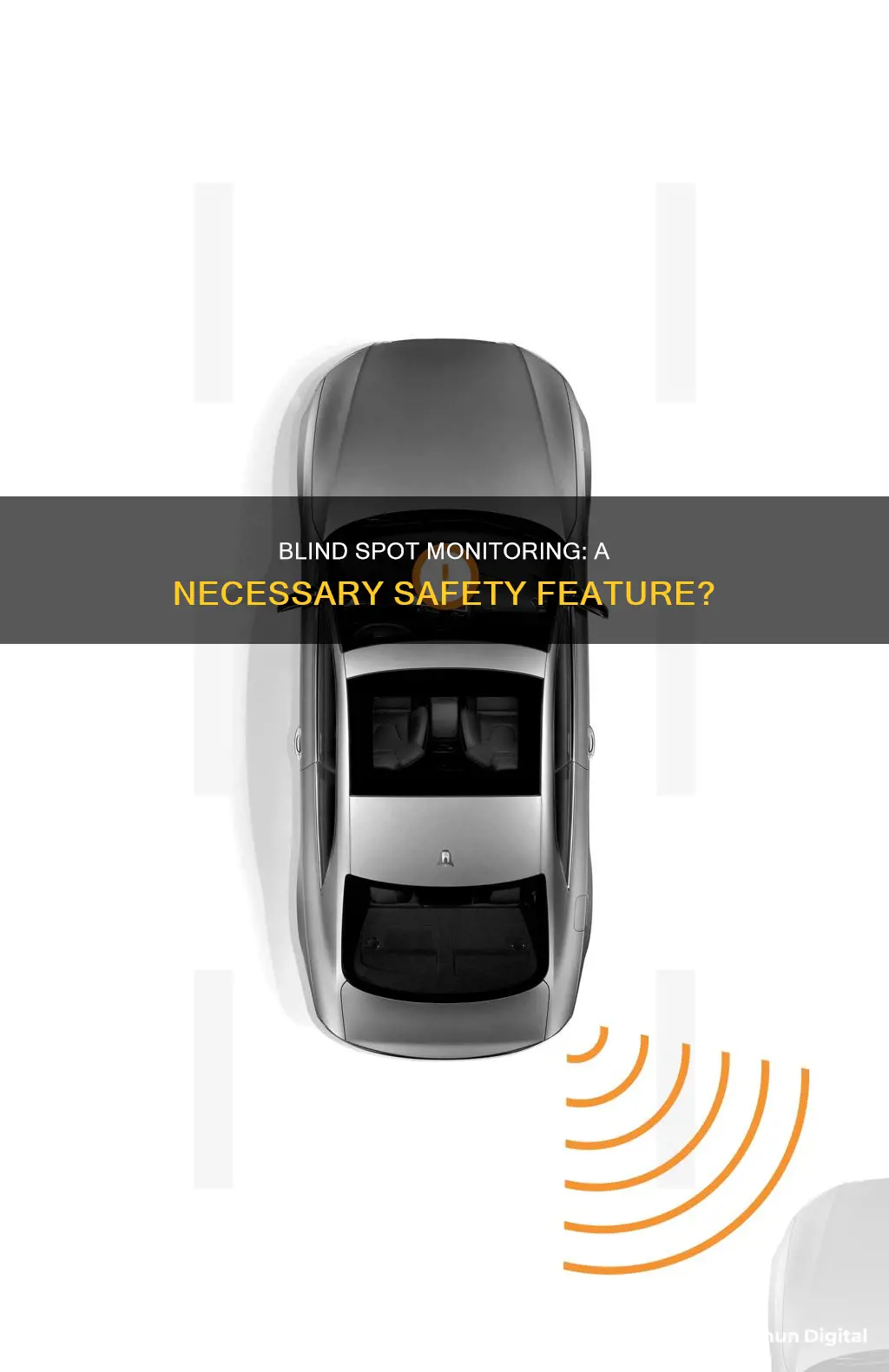
Blind-spot monitoring is a safety feature in vehicles that uses sensors, usually mounted on the side mirrors or rear bumper, to detect objects, vehicles, or people in the adjacent lanes that the driver might not be able to see. When the system detects something, it alerts the driver through audible or visual warnings, or both. While this technology was initially only available in luxury vehicles, it has now trickled down to more affordable cars, with some models even including it as a standard feature. However, despite its potential to enhance safety, blind-spot monitoring is not mandatory in new vehicles. So, is it worth spending extra on this technology?
| Characteristics | Values |
|---|---|
| Mandatory | No |
| Cost | The cost of blind-spot monitoring has decreased over the years, making it more accessible. |
| Effectiveness | Blind-spot monitoring is not foolproof but is generally reliable. |
| Safety | Blind-spot monitoring is a useful safety feature that can help prevent accidents and minimise injuries. |
| Types | There are two main types: Blind Spot Warning (BSW) and Blind Spot Warning with Automatic Emergency Steering. |
| Vehicle Size | Blind-spot monitoring is particularly useful for larger vehicles, which tend to have bigger blind spots. |
| Vehicle Type | Blind-spot monitoring is now available on a range of vehicles, from economy cars to luxury SUVs. |
| Visual/Audible Warning | Blind-spot monitoring systems use visual and/or audible warnings to alert the driver of potential hazards. |
| Sensors | Sensors are typically mounted on side mirrors or the rear bumper and use radar or ultrasonic technology. |
| Drawbacks | Some systems may struggle to detect fast-moving vehicles or motorcycles and may provide alerts too late for the driver to take action. |
What You'll Learn

Blind-spot monitoring systems are now available across the market, not just for luxury vehicles
Blind-spot monitoring (BSM) is an active driver aid that uses sensors and sometimes side-mounted cameras to detect vehicles in adjacent lanes, which may be hidden in a driver's blind spot. The system then alerts the driver with an audible or visual warning, or both. More advanced systems may also manipulate the steering or brakes to avoid a collision.
Initially, BSM was a feature only available in high-end luxury cars, but as the cost of the technology has decreased, it is now offered across the market. For example, it is standard on the Nissan Kicks S, which costs $19,500, and is available as part of a $500 Technology Package for the Kia Forte LXS, which costs $19,590. Blind-spot monitoring is also available as a stand-alone option or as part of an options package for vehicles where it is not standard.
Some automakers, such as Nissan and Ford, bundle blind-spot monitoring as part of their suites of active safety technologies. Others, like Toyota, Hyundai, Honda, and Subaru, restrict them to upper trims or more expensive vehicles. Blind-spot monitoring is also available as an aftermarket addition, with kits available from retailers like Amazon, Walmart, and Crutchfield, typically for $300 to $500.
While not mandatory, blind-spot monitoring is one of the most useful tools for keeping drivers safe. According to the National Highway Traffic Safety Administration (NHTSA), roughly 9% of all reported vehicle crashes each year result from changing lanes or merging. The Insurance Institute for Highway Safety (IIHS) reported that blind-spot monitoring reduces lane-changing accidents by 14% and injuries from lane-changing crashes by 23%.
Monitor Measurements: Size and Refresh Explained
You may want to see also

The cost of blind-spot monitoring technology has decreased
Blind-spot monitoring is a safety feature that uses sensors and sometimes side-mounted cameras to detect vehicles in a car's blind spots. When the system detects a vehicle, it alerts the driver through visual or audio cues. This technology was initially only available in high-end luxury cars, but as the cost of the technology has decreased, it is now offered across the market, including in economy cars.
The cost of blind-spot monitoring technology varies depending on the functions and technical parameters of the system. Basic systems can range from $100 to $150, while more advanced systems with features like a buzzer alarm or extra mirrors can cost between $150 and $300. The most advanced systems, with features like built-in camera screens and advanced alarm systems, can cost anywhere from $350 to $750.
The price of blind-spot monitoring technology is influenced by factors such as the number of parts in the package, the functionality and accuracy of the system, and the durability of the equipment. Additionally, the type of vehicle can also impact the cost, with truck blind spot systems tending to be the most expensive and motorcycle systems being the least expensive.
While blind-spot monitoring is not mandatory, it is an important safety feature that can help prevent accidents and minimize injuries. It is worth considering the benefits of this technology when purchasing a new vehicle or exploring options for adding it to an existing one.
Blind Spot Monitor: A Standard Feature on the Toyota RAV4?
You may want to see also

Blind-spot monitoring systems are not always effective
The effectiveness of blind-spot monitoring also depends on the driver's ability to notice the alerts. Many systems use visual cues on the side mirror, which can be difficult for the driver to see, especially in bright light conditions. Some systems provide audio alerts, but these are often only activated when the turn signal is used. If a driver fails to use their turn signal, they may not receive an audio warning in time to prevent a collision.
Furthermore, blind-spot monitoring systems are not always reliable in detecting pedestrians, cyclists, and pets. While these systems can reduce lane-changing accidents and related injuries, they are not foolproof. It is still important for drivers to check their blind spots manually and follow best practices when changing lanes or turning.
While blind-spot monitoring technology has improved over the years and is now available across a range of vehicle models, it should be used as a supplementary tool to safe driving practices rather than a replacement for them. Drivers should not become overly reliant on this technology and should still prioritize proper mirror adjustment and visual checks to ensure their safety and that of other road users.
Connecting a MacBook to an iMac and External Monitor
You may want to see also

Blind-spot monitoring is a useful safety feature
The system uses sensors mounted on the side mirrors or rear bumper to detect objects in the surrounding area. When the system detects something, it alerts the driver through audible or visual warnings, such as a warning sound, a flashing light on the wing mirror, or a vibration on the steering wheel. More advanced systems may also activate steering or brake controls to help the car stay in its lane.
Blind-spot monitoring is now widely available as a standard feature or optional upgrade across a range of vehicles, from subcompact cars to large trucks and SUVs. While it is not mandatory, it can provide valuable assistance to drivers, especially those who frequently transport children or drive on busy highways.
The effectiveness of blind-spot monitoring has been demonstrated in several studies. For example, a study by the Insurance Institute for Highway Safety found that blind-spot monitoring reduced lane-changing accidents by 14% and injuries from lane-changing crashes by 23%. Additionally, a study by the American Automobile Association (AAA) found that blind-spot monitoring systems struggled to detect fast-moving vehicles and motorcycles, which is a limitation of the technology.
Overall, blind-spot monitoring is a valuable safety feature that can provide drivers with additional information and assistance when changing lanes or turning. While it should not replace responsible driving habits, it can help reduce the risk of accidents and increase driver confidence.
Flat Panel LCD Monitors: Saving Electricity with Simple Tricks
You may want to see also

Blind-spot monitoring is not mandatory
The fact that blind-spot monitoring is not mandatory gives consumers the choice to decide if they want to include this feature in their vehicles. It is often offered as an optional upgrade or as part of a package when purchasing a new car. However, it is worth noting that some car manufacturers, such as Ford and Nissan, include blind-spot monitoring as standard in their safety technologies, while others like Subaru, Honda, Toyota, and Hyundai offer it only in their high-end or more expensive models.
The main purpose of blind-spot monitoring is to assist drivers in changing lanes and merging more safely. It uses sensors, usually mounted on the side mirrors or rear bumper, to detect vehicles, objects, or people in the adjacent lanes that may be hidden from the driver's direct line of sight. When the system detects something in the blind spot, it alerts the driver through audible or visual warnings, such as a beeping sound or a flashing light on the wing mirror or side mirror. More advanced systems may even provide a vibration on the steering wheel or activate steering or brake controls to help the car stay in its lane.
Despite the potential benefits of blind-spot monitoring, there are a few considerations to keep in mind. Firstly, the system may struggle to detect fast-moving vehicles or motorcycles, providing alerts too late for the driver to take action. Additionally, the effectiveness of the system can be impacted by external factors such as bright lights, which may affect the driver's ability to notice visual cues. Moreover, some drivers may find the frequent alerts or beeping sounds distracting or annoying, leading them to turn the system off.
Best ASUS Monitors with Mounting Holes for Easy Wall Mounting
You may want to see also
Frequently asked questions
Blind-spot monitoring is a safety feature that uses sensors to detect vehicles, objects, or people in a car's blind spot. It is designed to prevent accidents and increase driving awareness. While it is not mandatory, it can be a valuable addition to your vehicle, especially if you drive a large car or have difficulty adjusting your mirrors properly.
Blind-spot monitoring systems use sensors mounted on the side mirrors or rear bumper to detect vehicles, objects, or people in the adjacent lanes. When the system detects something, it alerts the driver through audible or visual warnings, such as a flashing light on the wing mirror or a vibration on the steering wheel. Some advanced systems can also activate steering or brake controls to keep the car in its lane.
Blind-spot monitoring can help prevent accidents and increase driving awareness. It can also provide peace of mind, especially when driving in close quarters or on busy highways. Additionally, it can relieve some of the stress of driving and help you feel safer and more confident on the road.







